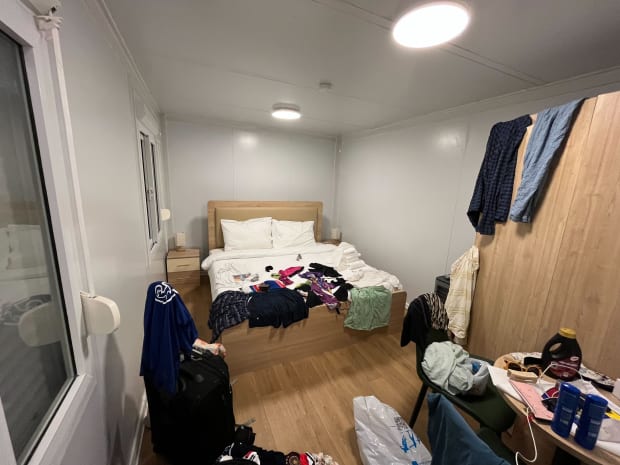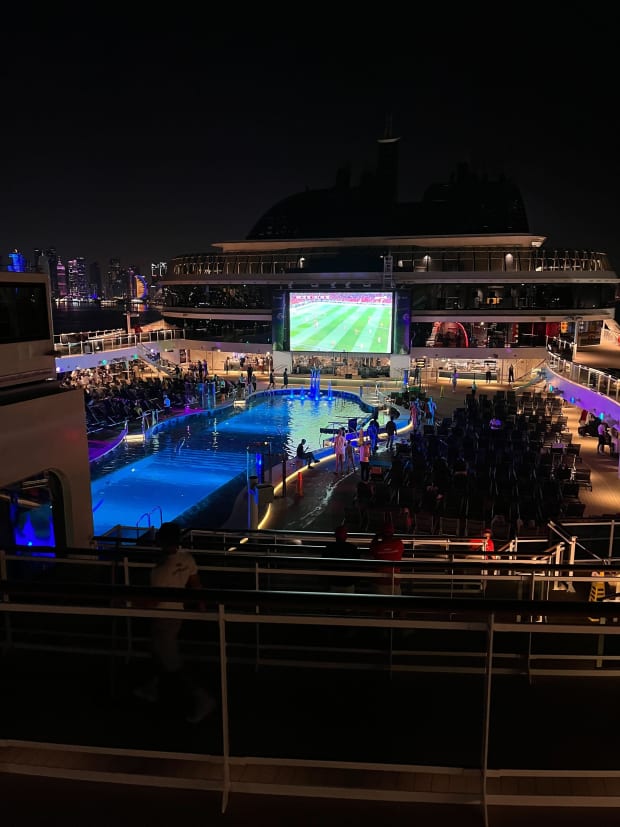The pub at the downtown Red Lion here fills with World Cup revelers on Saturday afternoon. They’re downing beers and cocktails. Smoking cigs. Munching on nachos made from Doritos—not bad, for what it’s worth—and burgers and onion rings. Gazing at flat-screen televisions, where Australia is tangling with Tunisia. It’s a slice of normalcy, in a place unlike any the World Cup has ever been held.
Eventually, the imbibing will end, and the revelers will head back to wherever they’re staying. And here, at the first World Cup held in an Arab country, where the host’s land mass is slightly smaller than the state of Connecticut, the where of the staying is where things get weird.
The very well-to-do fans with money to burn can light it on fire at any number of gleaming, towering luxury hotels. Others can sleep in the thousands of rooms that loom a little lower all over town. But at the most compact World Cup ever, held in one of the richest countries in the world, there aren’t enough available bookings for the 1.2 million visitors expected to descend.

Fu Tian/China News Service/Getty Images
Hence some, shall we say, creative solutions at a World Cup that will be remembered for the deaths of thousands of migrant workers, a November start date due to extreme heat in Qatar, the compact schedule, the beer flip-flop, the eventual champion and … some really odd lodging. Think tent cities, both in the camping sense and the glamping one. Think fan villages, where the rooms are not fashioned from shipping containers—they are shipping containers, complete with air-conditioning units. Think monstrous cruise ships docked off the Doha Port. Think anything, really, and chances are someone, from somewhere, is sleeping there, before heading off to one game or another.
Inside that pub at the Red Lion, five friends loosely tied by their passion for U.S. Soccer sit at the corner of the bar. Among them: Jesse McGannon, 36, from Lake Tahoe. McGannon is the traveling type, a wandering soul who worked in Singapore, using his down time to tour southeast Asia. He went to Brazil for the World Cup in 2014, then decided he’d go to every tournament he could for the foreseeable future. McGannon decided to scrap a sojourn to Russia after the Americans failed to qualify. But then a work trip—McGannon is a management consultant—fell through, clearing up his schedule during the tournament. He bought a same-day ticket by redeeming United miles, then went from Omaha to San Francisco to Germany to Russia. Again, same day(s).
McGannon met his wife, Choi, when they both played in an ultimate frisbee tournament in the Philippines. She shares his love of travel. But as this World Cup approached, they vacillated over whether to attend. “We were debating,” Jesse says. "Qatar, or take a two-week trip to all the countries competing from Europe and just watch in pubs.”
Part of their hesitance stemmed from the logistical puzzle Qatar presented. Because none of the eight stadiums are farther than 34 miles apart, they wouldn’t need to constantly fly between different cities. In Brazil, for instance, Jesse slept on a hammock aboard a boat for four nights as it traversed the Amazon river. Then he flew to Rio and other places.
Here, they would stay in the same place, for roughly the duration of the tournament. But those other 1.2 million fans would be around and looking for somewhere to stay on the tiny peninsula, too.

Courtesy of Greg Bishop
After leaving the pub, Jesse and his friends split up momentarily. Jonathan Koehler, 39, and Naomi Thompson, 35, of Chicago, head over to their fan village to check into their shipping container. Room 1: occupied. Room 2: key doesn’t work. Room 3: also occupied. But then the workers at the village settle on a different solution. They climb to the second story and break into Room 2, unlocking it for their welcomed guests.
This kind of happening isn’t representative of most attempts at securing lodging during this World Cup, but it’s not exactly a shocking outlier, either.
On the ground, roughly a week before the World Cup opener, none of the odd lodging spots had opened. Construction continued, at all hours, even through the night. It wasn’t possible to look inside, even, not at the tent village in Al Khor, not at the fan village stocked with shipping containers and not at the cruise ships. They were all heavily guarded. And the guards, while not unfriendly, all insisted that only ticket holders—not journalists or those who flew in for the atmosphere and will not step foot inside the stadiums—are allowed.
The same day, on a taxi ride all over Qatar, the driver pointed to a complex 30 miles outside of downtown. The buildings were blue and blocky and stretched for a mile or so in the distance. They looked like military barracks and, apparently, they can house up to 50,000 fans. They were built in the last few months, the driver said, pointing to the national flags that hung from the walls.
The haste owes to the math: 40,000-ish available rooms, according to government officials, new hotels still being built (as in now, after 16 days on the ground) and a visitor count in the seven figures. Throw in hostels, apartments, floating hotels (that aren’t ships but are suspended in the water), desert camping sites, pitch-side suites (hotel rooms, seriously, built into the upper concourse at Al Bayt Stadium, site of the opener) and everything else (flight shuttles from Dubai or Oman; busing in from Saudi Arabia), and the numbers still don’t add up. Pitch-side living comes with its perks, by the way: king-sized beds that can be converted into couches, for watching soccer matches through floor-to-ceiling windows, after a little nap.
The McGannons planned to stay for 11 nights—at four different types of lodging. As they depart on Nov. 19, they know not to expect too much of anything.
Jesse belongs to several U.S. soccer fan groups, and he knows that fellow World Cup obsessives like Las Vegas–based Marcus Cranston and Lila Asnani—you might recognize them from broadcasts as Eagleman and Wonder Woman, per their costumes—had lodged in all types of places, all over the world.
They stayed with relatives in London and commuted to France in 1998. On the same trip, for a different match, they stayed in a small room and had too much to drink and woke up with three dudes sleeping like three-quarters of a rectangle around the bed. They stayed on a military base in South Korea while Cranston was still in the Air Force, working as a physician and retiring as a colonel. They even stayed, after a mix-up in the Amazon, on their wedding anniversary no less, in a room that contained only a bed and a tile shower-and-toilet combo. The sign affixed to the wall was in Portuguese, and while neither spoke the language, the image—of a condom—was universally understood.
The atmosphere, all believe, whether kooky or distinct or, well, brothel, is part of the charm, as long personal safety is secure and they can get to the matches on time. So Eagleman and Wonder Woman were prepared for some things to go wrong in Qatar. But even they couldn’t have anticipated the particular bizarreness that would accompany this particular tournament.

Courtesy of Greg Bishop
Before the tournament, as Jesse looked at his options for lodging in Qatar, he became intrigued, torn. Hotel availability seemed limited. But perhaps he could find a hotel … and a shipping container … and an apartment … and a room on a cruise ship.
The deeper he dove, the more fascinated he became. Digital renderings of fan villages—projection screens, bean bag chairs—called like a siren to his soccer fan soul. Normally, he would have avoided cruise ships, because he considered them a “Disneyland version” of the ideal traveler’s experience, pre-packaged and less than authentic. But the ones in Qatar didn’t appear that way at all.
Still, he was a little wary. “I was a bit nervous,” he admits. “Especially after watching all the Fyre Festival documentaries.” He’s referring to the disastrous luxury music festival that conned investors out of $26 million and resulted in customers arriving on an island without the food or accommodations they’d been promised.
But he bit the bullet and booked. Flights, tickets and a chain of accommodations that may or may not have existed.
On their flight from San Francisco to Doha in mid-November, Jesse and Choi received an email from the Element Hotel. It was supposed to open Nov. 15. Four days later, while they sped toward a bed that was open but no longer available, the hotel said it hadn’t been approved for guests. At least the hotel had a plan, though. They would be booked at Delta Hotels by Marriott City Center instead.
This, they would find out, presented a considerable upgrade. Their room is in the “residences” portion of the property, which means 800 square feet, two bedrooms, three bathrooms, a washer-dryer unit and a dining room table with eight seats. No one had ever slept—or eaten or laundered—in this particular residence before.
Naturally, they decided to take advantage of this twist and wash their clothes. They put a load in and headed out for the day. They came back and found the machine still beeping, like it was broken. Jesse peered behind the unit. It was connected to a water valve. But the valve wasn’t turned on. No biggie. Worth the upgrade.
Days later, the McGannons check into their MSC cruise ship, the World Europa, and the process is smoother, the room small but clean and well-appointed. A reporter from Spain asks Jesse to send pictures and video from inside. There’s a whole ship city to document: 14 hot tubs, none with time machines; six pools, the spa’s thermal baths; areas for children; a bevy of restaurants, some casual, some fine dining; multiple buffets; bars and lounges, one panoramic; bumper cars; video arcades; a water park. The only difference in Doha, compared to normal voyages, is that the casino shut down due to the government's anti-gambling prohibitions.

And … slides. So. Many. Slides. All describe the longest as perched at something like an 85-degree angle, and they don’t push themselves down, because the floor drops out from underneath them, and they shoot down the tube like a scuba diver moving at the speed of a Formula 1 car. Christianson suffers his first World Cup injury due to a poor landing. Injury aside, “It’s kinda like summer camp,” he says.
Jesse loves the craft beer cart, featuring hops from Italy, and tools around the pool. Plus, the spritz cocktails that are buy-one-get-one-free. Plus, the gin experience, although he runs out of time to try that one. Plus, the promenade. The Mariachi bands. The orchestra. The culture. The other fans, from other places. The Brazilians who buy rounds. The Serbians who partake in hot-tub hopping. It’s all perfect, and all a little much.
After a few days, the McGannons headed toward the most unusual experience of all: their shipping container, which the hosts have called “huts” in an attempt to fool visitors into believing they’re not sleeping in a shipping containers. Several fan villages in Doha and on its outskirts were stuffed with rows of the same. The paint on the outside of the containers almost forms the kind of rainbow that officials will not allow on T-shirts worn into stadiums—one row is bright yellow, the next a light purple, then light blue, then orange.
Jesse heard the horror stories, many Fyre Festival–adjacent. Check-in lines stretching for blocks. Guests turning keys to containers to find other guests inside. Complexes of these rainbow-painted containers still under construction. But he and Choi checked in easily, found their room gloriously unoccupied and, to their surprise, cold as an igloo. Each container, apparently, comes with its own AC, lest occupants bake after the sun rises.
There were bean bags! Projection screens! Fellow travelers! The only drawback was the location of this village, on the far west side of town.
This is his review of the container room itself: You could tell they’re building them in a hurry. … They’re nice enough … like Motel 6–quality rooms. … You walk in, and immediately you’ve got a bathroom to the right. … The seal on the cylinder that shuts the shower doesn’t close, so the bathroom floor gets really wet, because there’s nowhere to drain. …
Here, Choi interjects. “You’re just a splasher,” she says.
They decided to think about the containers the way they think of a tent when they go camping. Similar comfort level. Less-than-the-best sleep. An experience. They turned down the AC. They fell asleep on beds that might have been fashioned from concrete. “I’ve slept in far worse,” Jesse says, having crossed “stay in a shipping container in Qatar” off his bucket list.
His Tokyo-based friend, Casey Christianson, 36, wasn’t as fortunate. He arrives at a different fan village, albeit one that features the same sleep-in-a-box containers, to find one person at the check-in counter and about 100 angry people with suitcases in hand. Every time this person came back to the counter, the crowd swarmed, growing angrier by the minute.
At one point, Christianson backed away from the crowd, and when he did, he spied another employee minding his own business.
“You checking anybody in?”
“Yeah, sure.”
At this moment, Christianson has already won the lodging version of the World Cup.
Still, Christiansen and the McGannons all noticed that their respective villages were still being built. They believe the room confusion owes, in part, to officials booking rooms they have not yet constructed. They heard of guests who check in to find unfurnished spaces, or parts of roofs missing. Some found toilets that had been, um, used—and recently; others, no door; still others, floors decorated with mud. Different employees gave various answers (pro tip: keep trying, one will be right!). Televisions in the compound didn’t work. Restaurants ran out of food. Turf underfoot hadn’t been laid down. Mud reigned. Missing fixtures. All of it. And, since letters of the alphabet mark the various containers, they saw folks check in for “E” and signs for, say, “R” or “S” still lying on the ground. Those rows will ostensibly go up next!
“A just-in-time supply chain,” Jesse says.
Still, one night Jesse spies a group of young Iranians playing soccer with some middle-aged men from Ireland. And, right then, somehow, all feels right with the world.







